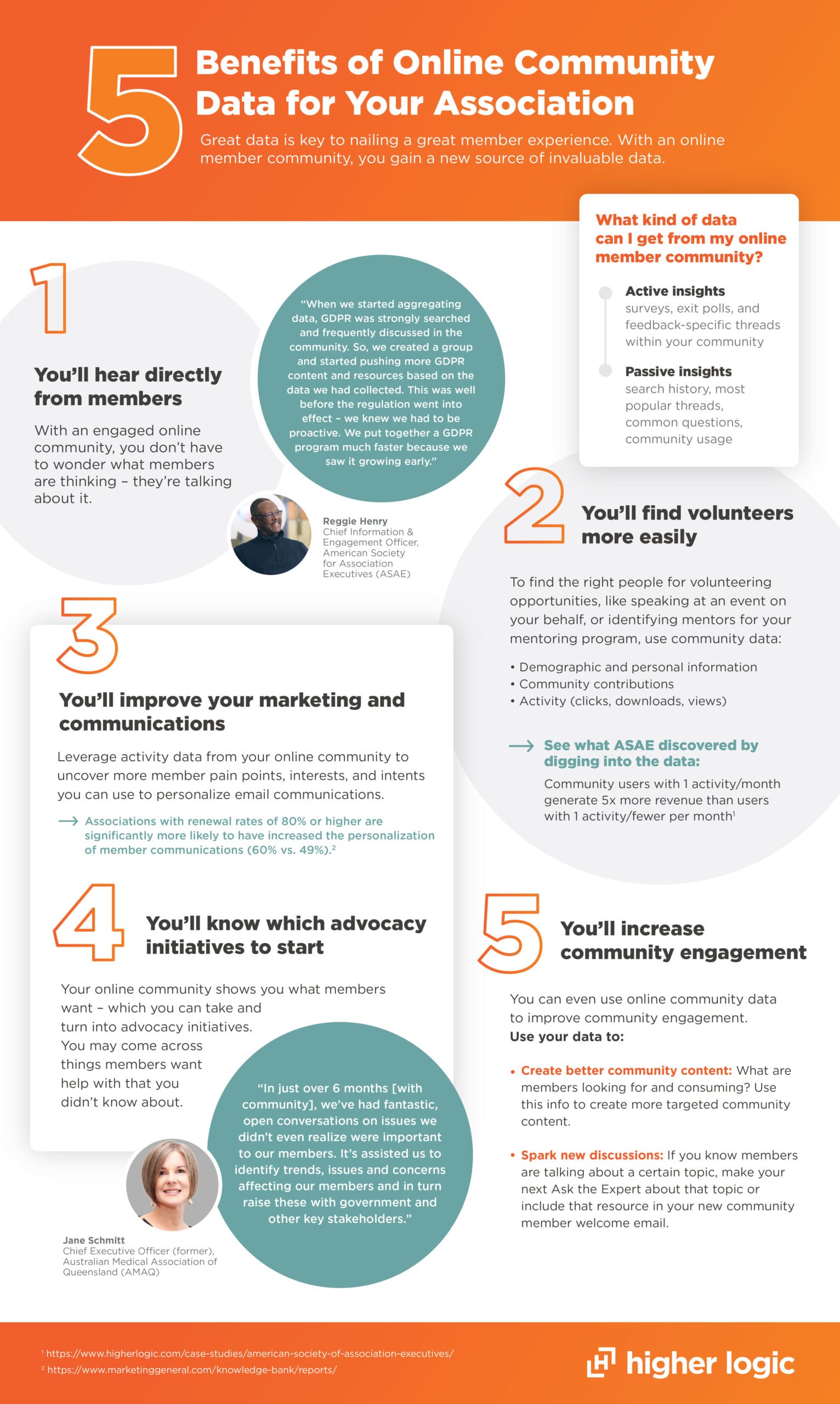
Insight to Action: 5 Ways Your Association Can Use Online Community Data
If you have an online member community, you have an invaluable source of member data. Here’s how to put it to work.
You can provide high-quality content for your members all day long — but it won’t help you much unless members also feel that it’s timely and highly relevant for them. That can be challenging, considering your members are at different career stages and have varied needs.
The foundation of an excellent member engagement strategy is to start with member data. With the right data, you can create more member-centric experiences to truly engage your members.
But where to find that data?
If you have a website and/or send out emails, that’s great — start there. What are members clicking on? What pages do they spend the longest time on?
If you have a marketing automation platform, even better — you have a way to harness that data through website tracking and robust email metrics.
But best of all? An online member community. You have an invaluable source of data at your fingertips. Members are generating valuable behavioral data ready for you to apply to your engagement strategy.
Check out our infographic below to see the 5 ways online community data can benefit your association.

Online Member Communities Produce 2 Main Types of Data
In general, there are two types of online community data you can learn from:
- Active insights: Derived from asking members about their preferences, through surveys, polls, and feedback-specific threads within your community
- Passive insights: Derived from behavioral, demographic, and transactional data within the community, such as search history, most popular threads, common questions, and community usage
| Active Insights | Passive Insights |
|
If you’re thinking about implementing new offers, programs, events, or revamping your membership tiers, begin with active insights so your members can tell you exactly what they think about the idea. Active insights primarily gauge reactions to ideas and can be a faster way to get insights — enough so you know if it’s worth investing in more research on a specific offer or prototyping a product. The downside of active insights is that it only goes so far. Just because your members don’t ask for something directly, doesn’t mean they don’t need or want it. |
Passive insights are the real magic of an online community. There are three types of passive insights:
It’s one way to listen to your members without asking them directly. |
Use Online Community Data to Engage Members Better
Now that you know what your online community can provide, let’s dive into 5 ways your association can put that data to work.
1. Build a better member experience
An online community gives you direct access to what your members want and need.
With an engaged online community, you don’t have to wonder what they’re thinking – they’re talking about it.
Communicating with members and actively seeking their feedback on processes, programs, and product roadmaps are key to transparency. While a strategy like this may require you to break down walls and address concerns in your organization, the positive results are real.
The American Society of Association Executives’ (ASAE) community, Collaborate, has helped them identify trends in member needs. For example, when they saw an uptick in conversations around GDPR in their online community, ASAE was able to quickly provide content that addressed members’ concerns.
“When we started aggregating data, GDPR was strongly searched and frequently discussed in the community. So, we created a group and started pushing more GDPR content and resources based on the data we had collected,” says Reggie Henry, Chief Information & Engagement Officer of ASAE.
“This was well before the regulation went into effect – we knew we had to be proactive. We put together a GDPR program much faster because we saw it growing early.”
By listening to your members, you can foster a better experience across your products, communication channels, or your programming. Your community can help you:
- Improve your program offerings. Your members are telling you what they want. Realistically, you may not always be able to make every item happen, but you have a deeper understanding of their real needs, which can guide your strategic roadmap.
- Improve how members feel about you. Openness to feedback and transparent communication is going to create genuine relationships between you and your members.
“Someone can now alert me when conversation X reaches a certain threshold, so myself or others can get in front of it, whether it’s answering a question or assessing a certain product or service based on member feedback.”
— Reggie Henry, Chief Information & Engagement Officer, ASAE
2. Find more volunteers
Identifying the right candidates for volunteering opportunities, like speaking at an event on your behalf, or identifying mentors for your new mentoring program, is just a matter of using the community data in front of you:
- Demographic and professional information from user profiles provides insight into skillsets within your community, so you can see if they’re a good fit for volunteer needs.
- Community contributions. The material that your community posts is another way to identify people with the skills you need. Look for file uploads, published blogs, and experts who answer forum questions with knowledgeable information. The more often they’re helping other people, the better candidate for a volunteering opportunity they’ll be.
- Interest, determined by those searching for “volunteer opportunities.” Then look at who visited your volunteer information pages and downloaded your volunteer guidelines and other documents. These folks are already interested enough in volunteering to seek out more information on their own, so they’re great candidates if you need more help.
By analyzing their demographics and behavior, you’ll be able to determine candidates for these programs, who can help with creating content, doing interviews, and lending their expertise to areas where you need help.
With Higher Logic’s volunteer management software, you can easily organize your volunteers and programs. Each volunteer has a profile where they can submit their interests, and a recognition program helps you show appreciation to members for their involvement.
3. Improve member marketing & communications
To keep up with your member expectations, you need to tailor your messaging and content for each member segment. By customizing experiences in your online community, on your website, and in your marketing and sales communication, you help members feel appreciated and understood – and even help grow your revenue.
Before you can even think about personalizing your communication, however, you have to know what your members need and want – and what each one of them is interested in. Leverage activity data from your online community to gain insight into their pain points, interests, and intents, and use those insights to personalize the experience.
For example, some of your users may enjoy weekly emails, while others will hit delete without opening them. Some love posting in the community, while others prefer just to respond to posts others create.
“This new data analysis helps me get a general idea of conversations occurring across the larger member community, so I can better navigate those members to their cohorts. We can use this demographic data from the AMS and community to steer a member to the right place, where they find valuable, relevant conversations.”
— Megan Kuhman, Senior Manager of Online Communities, ASAE
Use your member activity data to personalize communication and content. For the person who loves events, send an email with information on upcoming registration periods or links to event speaker blogs. For those that prefer online interaction, give them information about ways that they can get involved and share their ideas in your online community.
You can also employ data to give members more of the content and programs they like. If passive insights show that event wrap-up blogs perform well, write more of them. If active insights contain requests for more professional development options, institute more training opportunities or mentoring programs.
Act on the insights your community’s activity data provides and build custom content and programs that are hyper-relevant. This builds trust in your organization and keeps your members coming back to your community again and again, driving more value.
4. Start the right advocacy initiatives
Your online community gives you a wealth of insight into what members want – which you can take and turn right into advocacy initiatives. You may even come across things members want help with that you didn’t know about.
For example, when the Massachusetts Society of CPAs (MSCPA) launched their online community, community discussions about tax software problems caught the attention of MSCPA’s Government Affairs Director, Zach Donah. The conversations highlighted issues between CPAs and the Department of Revenue (DOR), including technical issues and software glitches that MSCPA wasn’t aware of, so it stepped in to help.
“We saw people asking things like ‘Is this normal?’ or ‘Are you experiencing this too?’ when talking about software. Our government affairs director saw the discussion and stepped in as liaison,” said Kara Kieran, MSCPA’s director of member engagement.
Zach took the issues to the DOR and worked with them to find resolutions. MSCPA then posted updates and information in the community to keep members in the loop and let them know that a solution was on the way. This was a new benefit for many members.
“People didn’t realize we could help them in these ways until they were posting on the community and actively saw that we were responding and assisting them,” said Kara. “Advocacy is a great benefit we often can’t get members to appreciate until they’re in a position where they need it, and we can show them.”
The community provided the avenue MSCPA needed to advocate for its members, highlighting a little-known benefit of their association.
See how the Australian Medical Association of Queensland was also able to use online community for advocacy:
“Before we created our Higher Logic Community, the Queensland Doctors Community (QDC), we had a number of different channels through which we engaged with members – but wanted one central source of truth. Now, we have a central hub for communicating with members, where they can engage with one another whenever they want to about trends, lessons learned, issues – anything they’d want to discuss with their colleagues.
In just over 6 months, we’ve had fantastic, open conversations on issues we didn’t even realize were important to our members. It’s assisted us to identify trends, issues and concerns affecting our members and in turn raise these with government and other key stakeholders.”
— Jane Schmitt, Chief Executive Officer (former), Australian Medical Association of Queensland (AMAQ)
5. Create better community content & increase community participation
Your own community generates a wealth of data you can use to actually improve online community engagement.
For example, use your community data to:
- Create better community content: Review the search terms report within your Higher Logic Community to identify top searches. What are members looking for and consuming? Those are the questions your content should answer. Dig into this data and use it to create more targeted community content.
- Spark new discussions: If you know members are downloading a resource on a certain topic, make your next Ask the Expert about that topic or include that resource in your new community member welcome email.
With a Higher Logic community, you can see what members are talking about in your community, and how often. The thread reports provide aggregate data for each community’s discussion and question activity, such as the percentage of discussions/questions with a best answer, the average time to response, and average time to best answer.
Tip: Engaged members are higher-spending members
ASAE knew their community was a strong member benefit, but insights gleaned the community extends beyond just a place for members to interact: They found that community users with at least one activity per month generate 5 times more revenue than users with one activity or fewer per month.
Put Online Community Data to Work
The best part of all of this? Well, two best parts. First, Higher Logic’s Community automation rules cut out so much manual work to help you categorize and act on data, easily. For example, let’s say you’re looking for enthusiastic community members to volunteer. You can use automation rules to identify a group of community members who have posted over 20 times this year and automate an email to these members inviting them to become volunteers.
Second, Higher Logic integrates with many association management software (AMS) and customer relationship management (CRM) tools, making the data transfer back to your database nice and easy. This enables you to pull community data and use it in other ways, like personalizing your email communications.


